Product + AI Image Creator - Meta Ads, Email, Social with fal.ai & Placid
• members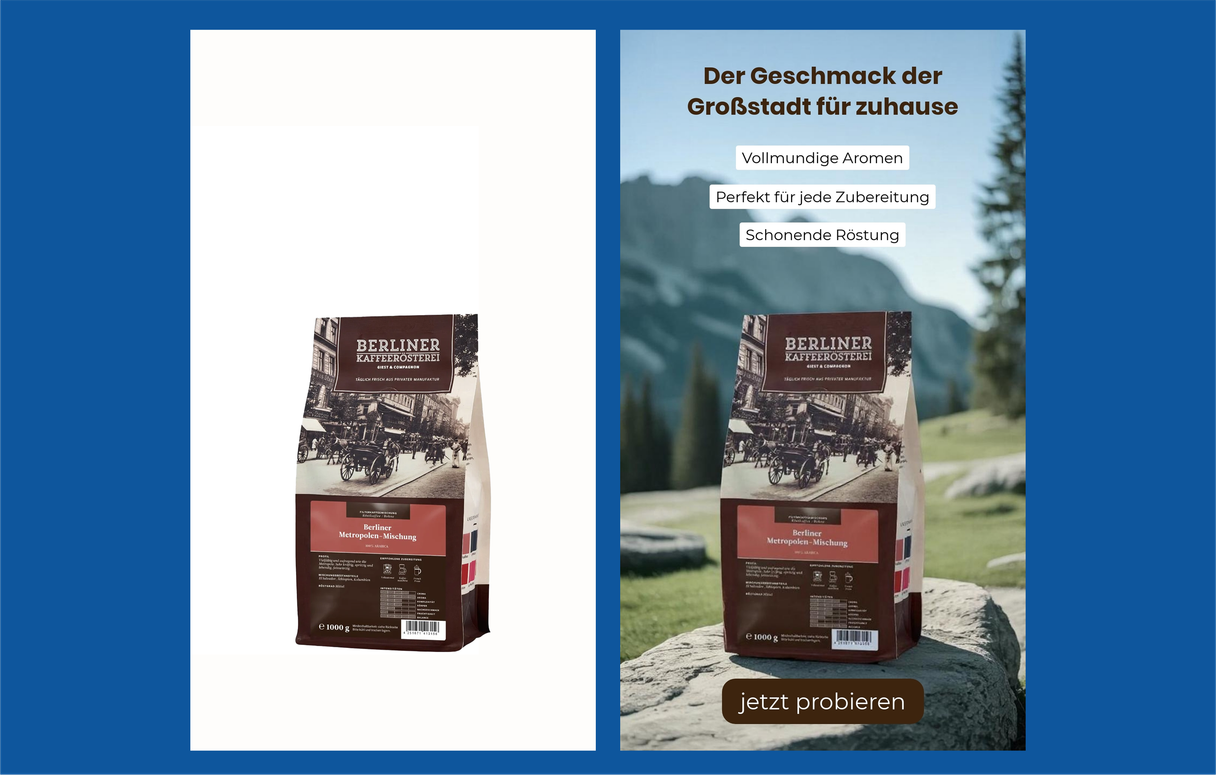
This workflow automatically transforms product photos into professional marketing visuals by placing them in custom backgrounds while preserving product details and text legibility. The system uses multiple AI models in sequence and Placid templates for precise control over final layout and text placement.
The Core Challenge: Preserving Product Integrity
Most AI image generation tools distort products when changing backgrounds - text becomes unreadable, logos get warped, and fine details disappear. This workflow solves that problem by using specialized AI models that maintain product integrity while seamlessly integrating new environments.
Workflow Architecture
The system processes images through five stages:
- Input Processing - Upload product image and specify requirements
- AI Copywriting - Generate marketing copy from website analysis
- Background Generation - Create style reference images
- Product Integration - Replace background while preserving product
- Template Assembly - Combine elements using Placid for precise control
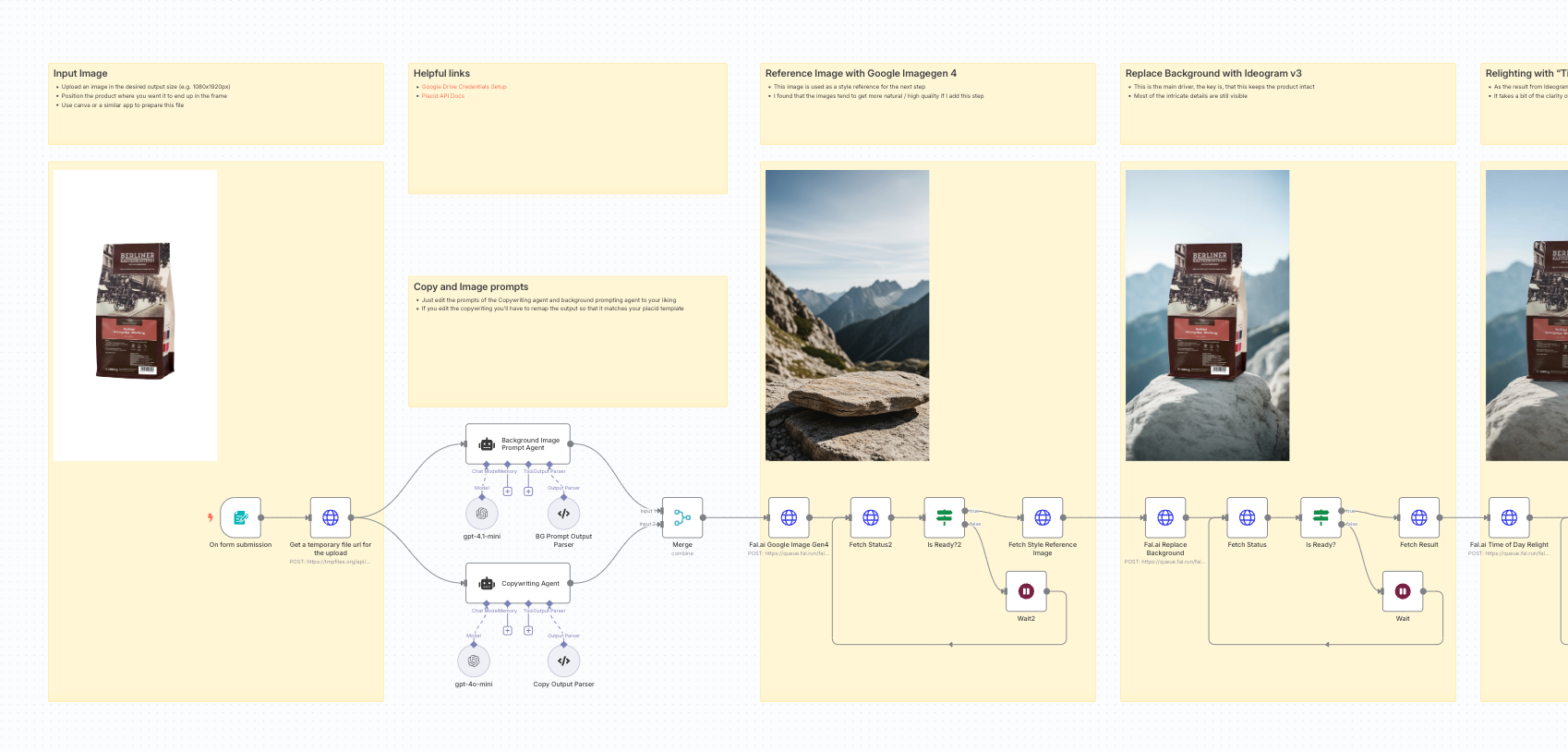
Stage 1: Input Processing
The workflow starts with a form requiring:
- Product Image: Original photo (recommended 1080x1920px)
- Scene Description: Target environment ("mountain scene", "beach setting")
- Website URL: For brand and copy analysis
- Lighting: Desired mood ("daylight", "golden hour", "moonlight")
The system uploads the image to temporary storage and passes it through the processing pipeline.
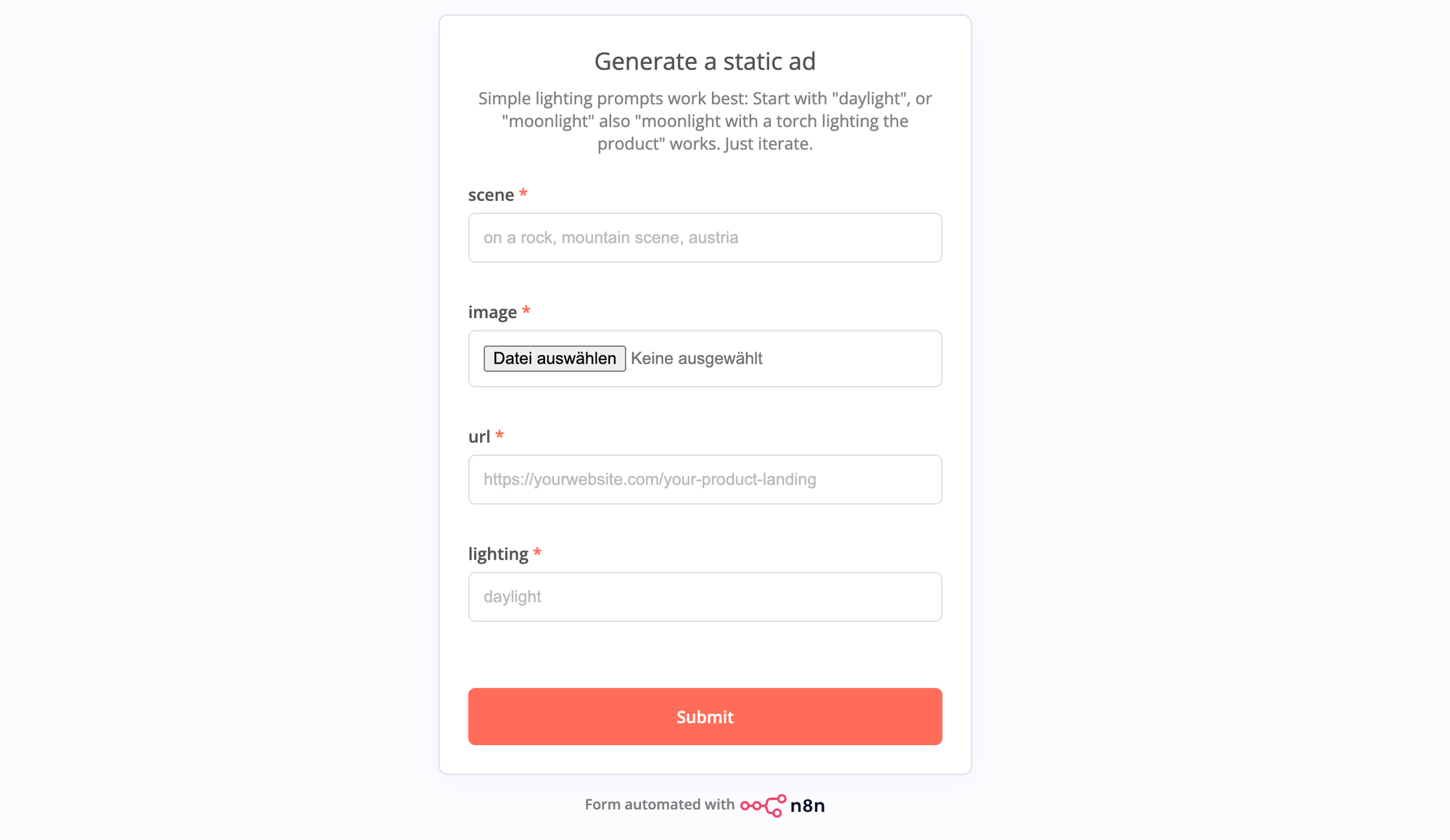
Stage 2: AI Copywriting Analysis
A GPT-4o-mini agent analyzes the provided website URL to extract:
- Brand positioning and voice
- Key product benefits
- Marketing messaging style
Output is structured JSON:
{
"claim": "Main headline text",
"bullet1": "First benefit point",
"bullet2": "Second benefit point",
"bullet3": "Third benefit point"
}
Stage 3: Background Scene Generation
A specialized GPT-4.1-mini agent creates detailed prompts for background generation. The agent:
- Analyzes brand aesthetic from the website
- Creates minimalist, premium scene descriptions
- Includes technical photography specifications
- Ensures scenes complement rather than compete with products
Example generated prompt:
"Photorealistic, minimalist beach scene with smooth driftwood surface, scattered seashells, pale sand, gentle ocean waves in blurred background. Soft natural daylight, pastel sky, clean composition with negative space. Canon EOS R5, RF 50mm f/1.2, aperture f/2.2, ISO 100, shallow depth of field"
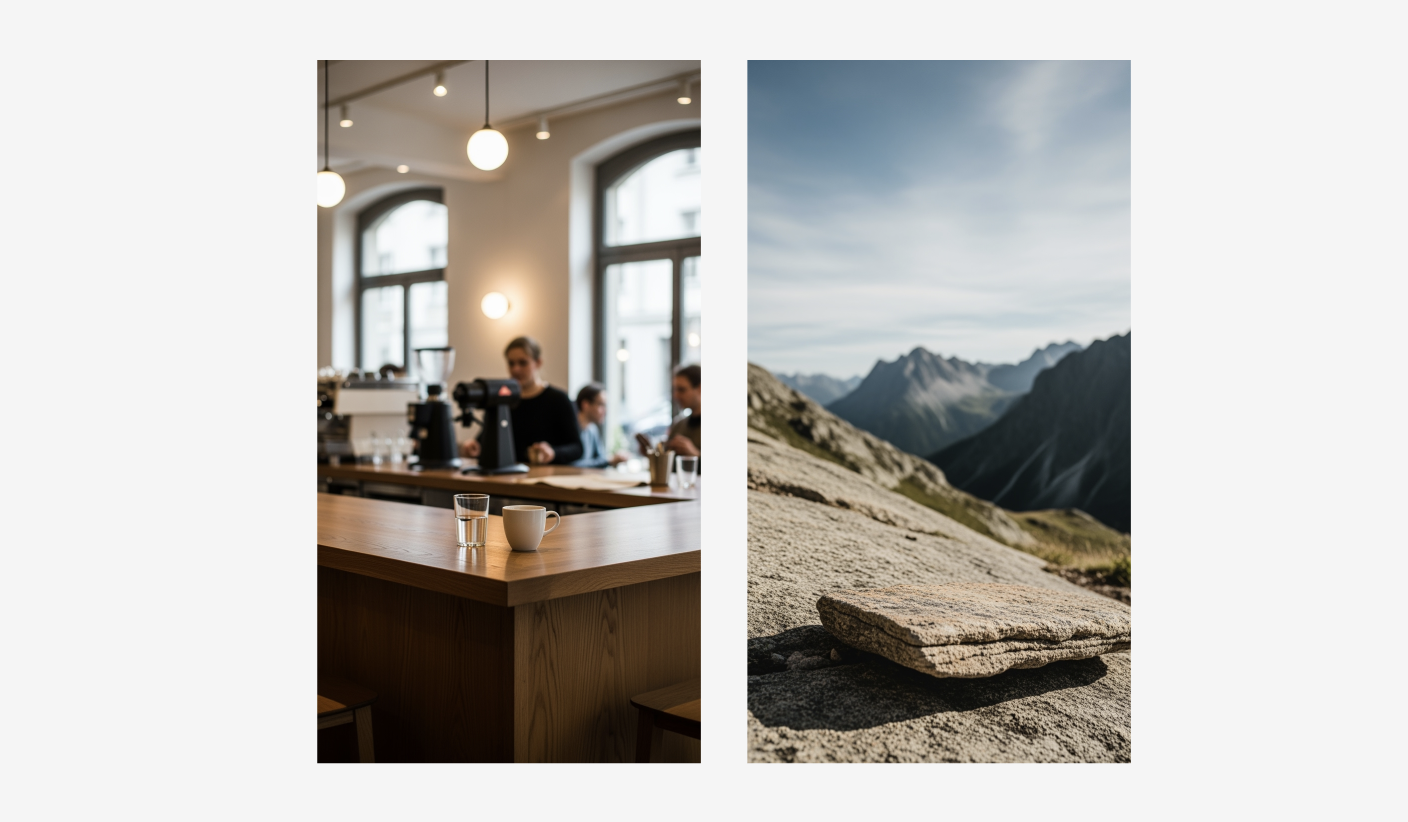
Stage 4: Multi-Model Image Processing
This stage uses three AI models in sequence to achieve high-quality results:
Google Imagen 4 - Style Reference
Generates a reference image using the background prompt. This serves as a style guide for subsequent processing and improves final image quality.
Ideogram v3 - Background Replacement
The critical step that replaces the background while preserving the product:
- Maintains all product details including text and logos
- Preserves perspective and scale relationships
- Integrates product naturally into new environment
- Keeps brand elements readable and intact
Fal.ai Time of Day Relighting
Adjusts lighting to match the specified mood:
- Creates realistic shadows and highlights
- Matches product lighting to environment
- Adds atmospheric effects
- Enhances overall realism
Note: This step may slightly reduce text sharpness but significantly improves photorealism.
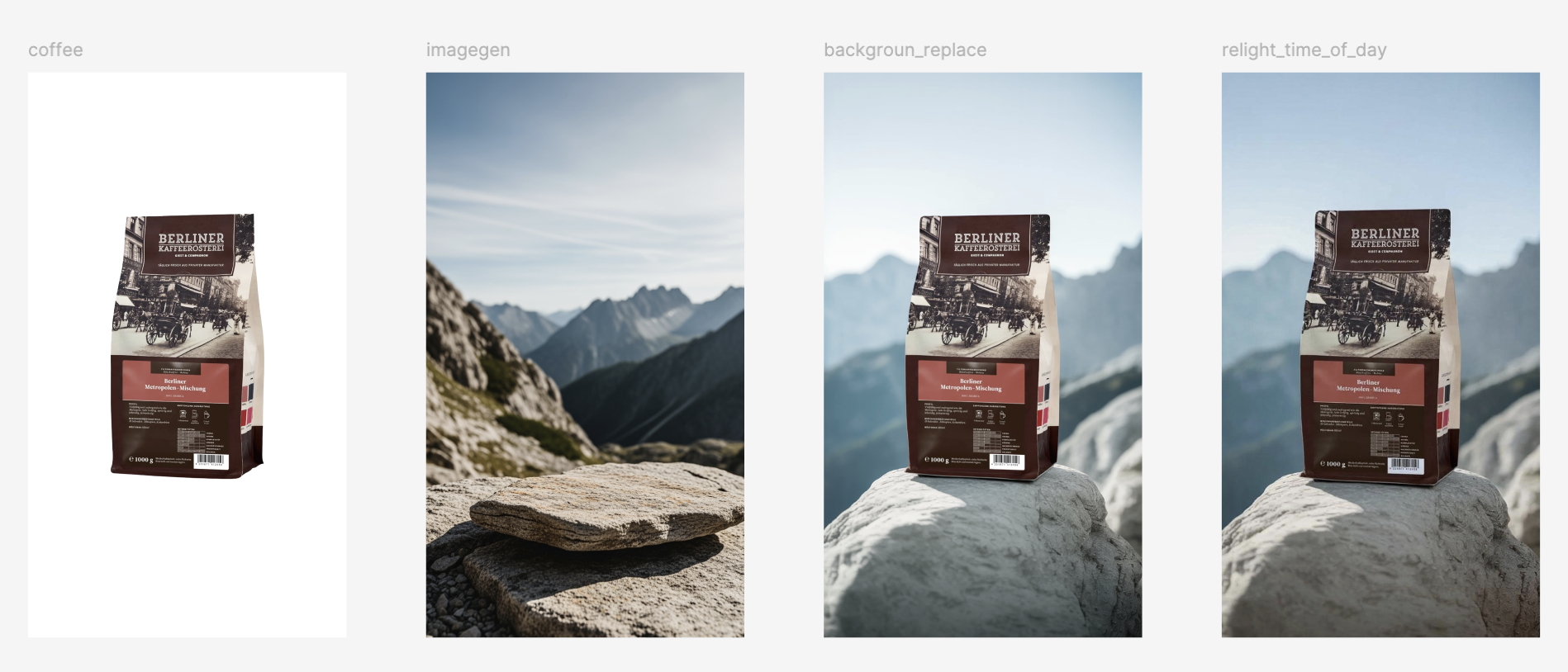
Stage 5: Template Assembly with Placid
Placid.app combines all elements using predefined templates:
Precise Control: Templates define exact positioning for images and text elements Consistent Layout: Professional typography and spacing across all outputs
Multi-Format Support: Same template works for various social media dimensions Brand Compliance: Maintains consistent visual identity
Template structure requires matching layer names to JSON output:
imagelayer: Final processed product imagesubtitlelayer: Main claim textbullet1,bullet2,bullet3layers: Benefit points

Technical Implementation
Built on n8n workflow automation platform with:
API Orchestration: Connects OpenAI, Fal.ai, Google Imagen, and Placid services Status Monitoring: Polls AI model completion status with built-in retries Error Handling: Automatic retries when models are overloaded File Management: Handles temporary storage and final asset delivery
Processing Time for one image: ca. 60s
Service Requirements
Required integrations:
- n8n: Workflow platform (free tier available)
- OpenAI: GPT models for copywriting ($0.01-0.03 per ad)
- Fal.ai: Image processing models ($0.10-0.20 per ad)
- Placid.app: Template system ($19/month for 500 credits/images subscription)
- Google Drive: File storage (optional, free tier sufficient)
Estimated cost per generated asset: $0.24
Template Configuration
Placid templates require specific setup:
- Create template with required layer names
- Position image and text elements
- Set fonts and styling to match brand
- Configure output dimensions for target platforms
- Test with sample data to verify layout
Layer naming convention must match workflow JSON output for automatic population.
Quality Control Factors
Input Image Quality: Higher resolution inputs produce better results Scene Compatibility: Simple, descriptive scenes work best Lighting Consistency: Match lighting descriptions to product needs Template Design: Well-designed templates ensure professional output
Common Issues:
- Complex backgrounds may cause processing delays
- Very detailed product text may lose some sharpness after relighting
- Extreme lighting conditions may require iteration

Output Formats and Usage
Generated assets work across multiple channels:
- Meta/Facebook Ads: Story and feed formats
- Instagram: Posts and stories
- Email Marketing: Header images and product showcases
- Website: Landing page visuals and product galleries
- LinkedIn: Sponsored content and company posts
The workflow maintains consistent branding across all formats while adapting to platform-specific requirements.
Workflow Customization
Key areas for customization:
Copywriting Prompts: Modify system messages to match brand voice Background Styles: Adjust scene generation for different aesthetics
Template Variants: Create multiple layouts for different campaign types Processing Options: Configure quality vs speed trade-offs
All customization happens through the n8n interface without requiring code changes.
Setup Process
- Install n8n (cloud or self-hosted)
- Import workflow JSON template
- Configure API credentials for each service
- Create Placid templates matching your brand
- Test with sample products to refine settings
Results and Capabilities
The workflow consistently produces marketing visuals that:
- Preserve product details and text legibility
- Integrate products naturally into custom backgrounds
- Maintain brand consistency across formats
- Generate professional layouts automatically
- Support multiple marketing channels from single input
This approach solves the fundamental challenge of AI image generation: maintaining product integrity while achieving creative flexibility and precise layout control.
This is a free resource for subscribers – you'll unlock the workflow file and updates whenever I publish new content. I don't have the time to spam you – I just want to share my knowledge and build a community of like-minded people. And you can obviously unsubscribe anytime if I happen to not deliver on my promise.